
Introduction:
In the rapidly evolving landscape of the Internet of Things (IoT), the proliferation of devices has led to unprecedented growth in data and energy consumption. As the number of IoT devices continues to soar, optimizing energy usage becomes imperative for sustainability and cost-effectiveness. Enter artificial intelligence (AI) – a powerful tool that’s revolutionizing the way we manage energy consumption in the realm of Massive IoT. In this article, we’ll explore the significance of smart energy optimization and how AI is playing a pivotal role in achieving it.
The Challenge of Energy Efficiency in Massive IoT:
Massive IoT refers to the interconnection of an enormous number of devices, ranging from smart sensors and actuators to wearables and industrial machines. These devices gather data and communicate with each other, making our world more connected than ever. However, this growth comes with a catch – the substantial energy demands of these devices. Ensuring the sustainability of Massive IoT requires us to find innovative ways to minimize the energy consumption of each device and the network infrastructure supporting them.
The Role of Artificial Intelligence:
AI, particularly machine learning and deep learning algorithms, provides the means to tackle the energy optimization challenge in Massive IoT. Here’s how AI is making a difference:
1. Predictive Analytics: AI algorithms can predict patterns of device usage and communication, enabling proactive energy management. By analyzing historical data, AI models can forecast peak usage times and dynamically allocate resources, reducing energy waste during idle periods.
2. Dynamic Resource Allocation: AI-powered systems can dynamically allocate computational resources based on real-time demand. This means devices can operate at lower power levels during periods of low activity, conserving energy without compromising functionality.
3. Anomaly Detection: AI algorithms can identify anomalies in device behavior that may indicate inefficient energy usage. These anomalies can then trigger automated adjustments or notifications for maintenance, ensuring devices are operating optimally.
4. Adaptive Connectivity: AI can optimize communication protocols and data transmission strategies based on network congestion and device priority. This reduces unnecessary data traffic and improves overall energy efficiency.
5. Energy Harvesting: AI can assist in optimizing energy harvesting techniques, such as solar panels or kinetic energy converters, to power IoT devices. By predicting environmental conditions and device energy requirements, AI ensures efficient energy capture and usage.
Benefits of Smart Energy Optimization:
Implementing smart energy optimization using AI yields several key benefits:
1. Reduced Costs: By minimizing energy consumption, organizations can significantly lower operational costs associated with powering and maintaining IoT devices.
2. Extended Device Lifespan: Efficient energy management leads to less strain on device components, resulting in longer device lifespans and reduced e-waste.
3. Environmental Impact: Smart energy optimization aligns with sustainability goals, reducing the carbon footprint associated with energy-hungry IoT deployments.
4. Enhanced Reliability: Optimized energy consumption enhances device reliability and reduces the likelihood of unexpected downtime due to depleted batteries or power issues.
Conclusion:
As the era of Massive IoT continues to unfold, harnessing the power of AI for smart energy optimization is a critical step toward a more sustainable and connected future. By leveraging AI’s predictive capabilities, dynamic resource allocation, and anomaly detection, we can strike a balance between the benefits of IoT and the need for energy efficiency. The synergy between AI and smart energy optimization represents a remarkable leap forward in shaping a greener and smarter world.
@2023 Gary H.Baiton
This content reflects the personal opinions of the author. It is accurate and true to the best of the author’s knowledge and should not be substituted for impartial fact or advice in legal, political, or personal matters.






Comments
There are no comments for this story
Be the first to respond and start the conversation.